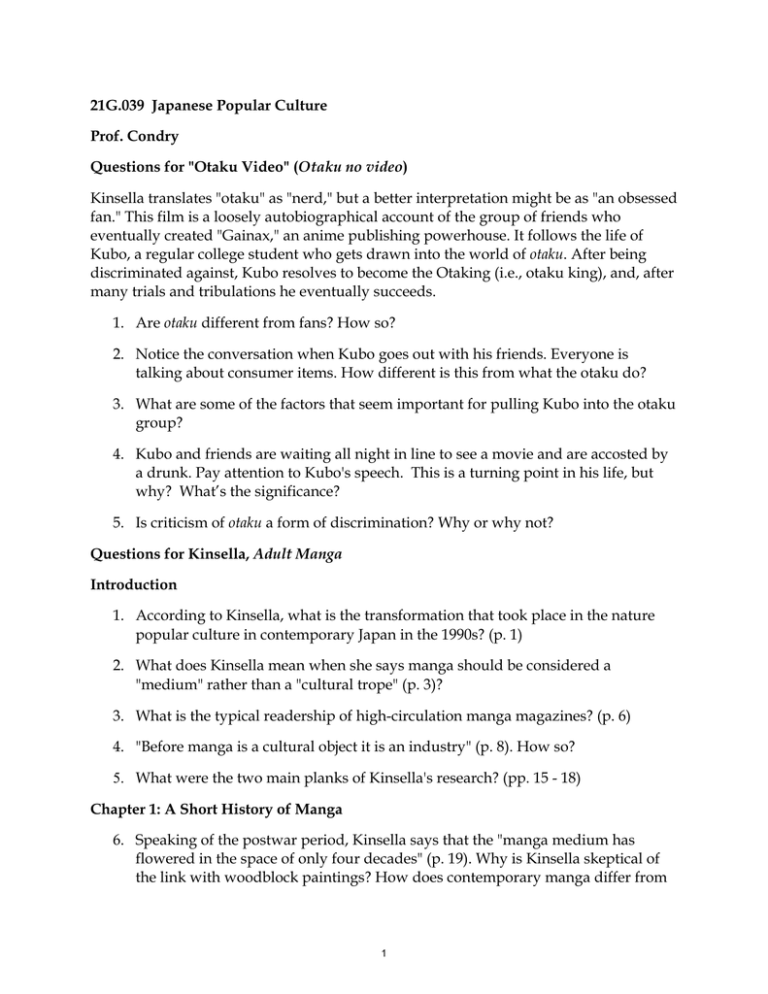G.039 Japanese Popular Culture 21 Prof. Condry Otaku no video
advertisement

21G.039 Japanese Popular Culture Prof. Condry Questions for "Otaku Video" (Otaku no video) Kinsella translates "otaku" as "nerd," but a better interpretation might be as "an obsessed fan." This film is a loosely autobiographical account of the group of friends who eventually created "Gainax," an anime publishing powerhouse. It follows the life of Kubo, a regular college student who gets drawn into the world of otaku. After being discriminated against, Kubo resolves to become the Otaking (i.e., otaku king), and, after many trials and tribulations he eventually succeeds. 1. Are otaku different from fans? How so? 2. Notice the conversation when Kubo goes out with his friends. Everyone is talking about consumer items. How different is this from what the otaku do? 3. What are some of the factors that seem important for pulling Kubo into the otaku group? 4. Kubo and friends are waiting all night in line to see a movie and are accosted by a drunk. Pay attention to Kubo's speech. This is a turning point in his life, but why? What’s the significance? 5. Is criticism of otaku a form of discrimination? Why or why not? Questions for Kinsella, Adult Manga Introduction 1. According to Kinsella, what is the transformation that took place in the nature popular culture in contemporary Japan in the 1990s? (p. 1) 2. What does Kinsella mean when she says manga should be considered a "medium" rather than a "cultural trope" (p. 3)? 3. What is the typical readership of high-circulation manga magazines? (p. 6) 4. "Before manga is a cultural object it is an industry" (p. 8). How so? 5. What were the two main planks of Kinsella's research? (pp. 15 - 18) Chapter 1: A Short History of Manga 6. Speaking of the postwar period, Kinsella says that the "manga medium has flowered in the space of only four decades" (p. 19). Why is Kinsella skeptical of the link with woodblock paintings? How does contemporary manga differ from 1 its precursor forms (comic strips, picture card plays)? 7. What were the key features of 1960s manga GARO, Tomorrow's Joe? In what way were they political (pp. 30-35)? What form did opposition to manga take? 8. In what sense were some manga of the 1970s "avant garde"? 9. How many companies dominate manga production (p. 40)? How did audiences for film change over the postwar period compared to manga and television? 10. How has serialization (p. 44) influenced the structure of manga stories? 11. What does Kinsella mean that "pornography has not been as strongly compartmentalized in postwar Japan" (p. 46)? 12. What does it mean that "readerships are 'sticky'" (p. 48)? What is the average age of readers of adult manga (p. 49)? Chapter 2: Manga Production Cycle 13. Possible essay question: "Change in the mode of production . . . is a vital aspect of how cultural change happens and one which is closely tied up with the question of freedom of expression, cultural democratization, participation and representation" (p. 50). Consider some of the changes in production of manga over time, and analyze how they relate to freedom of expression. In what ways is freedom of expression limited? 14. Which are more prevalent, independent studios or studios attached to big publishers (p. 52)? 15. How is power shared among the artists, editors, subcontractors, and others? 16. Why does distribution represent a major obstacle for small publishing companies (p. 68)? 17. What percentage of total manga revenue goes to the large publishers (p. 68)? Where are most manga sold (p. 69)? Chapter 3: Adult Manga and the Regeneration of National Culture 18. Manga were subject to "cultural assimilation during the 1990s" (p. 70). What does Kinsella mean by this? What are the key features of this process. 19. What was innovative about the manga Japan, Inc., Made in Japan, and A Manga History of Japan? 20. Who were two authors of "manga classics" (p. 77)? What did they produce? 21. What are some key features the new heroes of business manga? How contrast 2 with those of the past (pp. 79-87)? 22. International appreciation of ukiyoe (woodblock prints) and manga contributed to a transformation of the status of the forms in Japan (p. 93). How so? 23. What are the characteristics of the three kinds of manga studies Kinsella discusses (pp. 97 - 101)? Chapter 4: Amateur Manga Subculture and the Otaku Panic 24. What is the contrast between the treatment of underground manga of the 1960s and '70s compared to that of the amateur manga movement of the 1990s? 25. Amateur manga artists are part of a "shadow cultural economy" (p. 110). How is social class and gender related to the features of this cultural economy? 26. What are the characteristics of "yaoi" comics (113-17)? What is the difference between parody and original? 27. “Through parody manga young women have expressed an ambiguous preoccupation with . . . masculine gender stereotypes . . . " (p. 121). How so? What kinds of connections does Kinsella draw with the Lolicom genre (p. 124)? 28. What was the "Miyazaki incident"? (pp. 126 -28) 29. In contrast to the murderer, in what ways can otaku be considered elite? (pp. 129 - 131) 30. In what ways did otaku become used in debates about the shortcomings of Japanese society? Chapter 5: The Movement Against Manga 1. What was the main theme singled out for censorship as a result of the influence of the amateur manga world? What is the "more generalized pro-manga activity in society" that Kinsella says sparked the anti-manga movement? (p. 139) 2. While the 1946 constitution upholds the right to freedom of speech, the "Indecency Act" effectively stopped production of "indecent" manga. How did this happen? (Consider the relationship between the law, the structure of retail book stores, and concerns of publishers, p. 140). 3. In the 1990s, a new leniency in the enforcement of the Indecency Act may paradoxically "signify the emergence of a more severe code of decency" (p. 141). How so? 3 4. What is the difference between "harmful" and "indecent" when it comes to regulating manga (142)? What was the main complaint by feminist groups about manga (144 - 47)? 5. What was the nature of self-regulation of the manga industry (i.e., who met with whom about what) (147 - 49)? 6. What happened to Morizono Milk? What manga was censored for its political content? (150 - 52) 7. What strategies were used to appeal for freedom of expression? What was the basis used to justify more artistic freedom ? How was it also an argument for increased status for manga artists (157 - 61)? For example, why was the emphasis on "responsibility" important? Chapter 6: Creative Editors and Unusable Artists 8. What were the two major trends in the 1990s changing the face of manga production? With what changes in who provided the intellectual leadership in making manga (p. 162-63)? 9. The growing influence of editors was provoked both censorship of bad and by desire to emulate serious and successful manga like Japan, Inc. Why was Kodansha particularly concerned about making "good" manga? 10. How does social class figure in Kinsella's analysis of editors and artists? (166 - 72) 11. What are the characteristics of manga stories thought up by the editors Kinsella observed? (172 - 78) 12. What changes does Kinsella identify in the artists of the 1990s compared to those of the past? What has changed for the audience too? 13. How was "editorial nostalgia" translated into 1990s manga? 14. In what way were foreigners used in manga production? 15. What were the "new social relations in manga production"? (199 - 201) Chapter 7: Conclusion 16. How did the censorship movement and the process of cultural assimilation change the relationship between manga and society over the postwar period? How would you describe the "institutional apparatus" that distinguished "good" manga from "bad"? (202-03) 17. What sector(s) of the government were most active in censorship? What about cultural assimilation? 4 18. How does the movement against amateur manga relate to other anxieties about Japanese society? 19. What are some of the characteristics of "editor-centered" manga of the 1990s? 20. Kinsella concludes: With the end of the Cold War and the end of the left, the basis of popular culture in wealthy industrial societies was undermined. Popular culture has gradually been replaced by a retro corporate culture fashioned by producers and editors employed within culture industries like the manga industry. This corporate culture is fashioned according to cultural producers' ideas about the present and according to their recollection of the mode of popular culture of the past. (207) Could this be applied to certain areas of popular culture in the United States? Why or why not? 5 MIT OpenCourseWare http://ocw.mit.edu 21G.039 / 21G.037 Japanese Popular Culture Spring 2003 For information about citing these materials or our Terms of Use, visit: http://ocw.mit.edu/terms.





